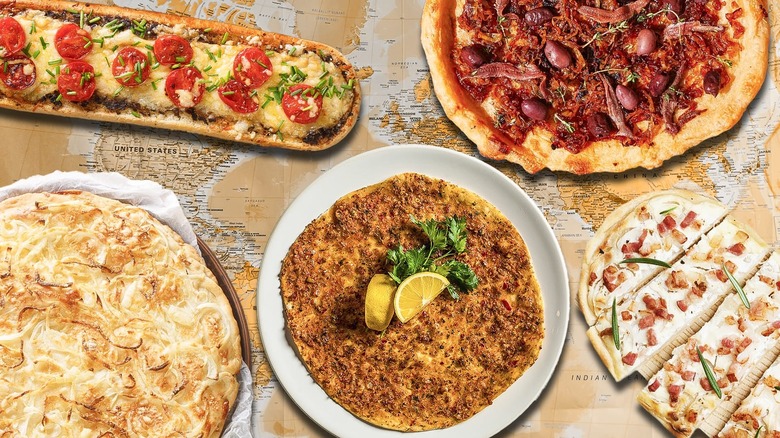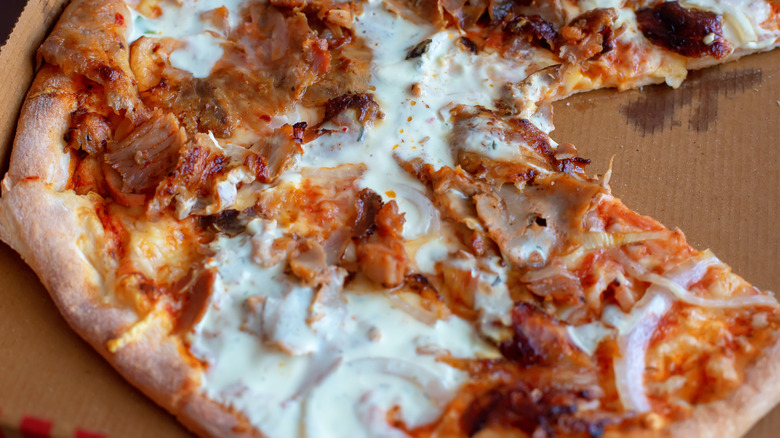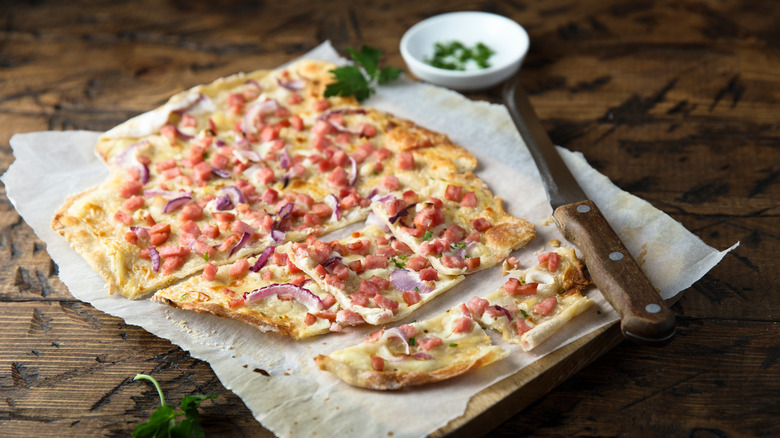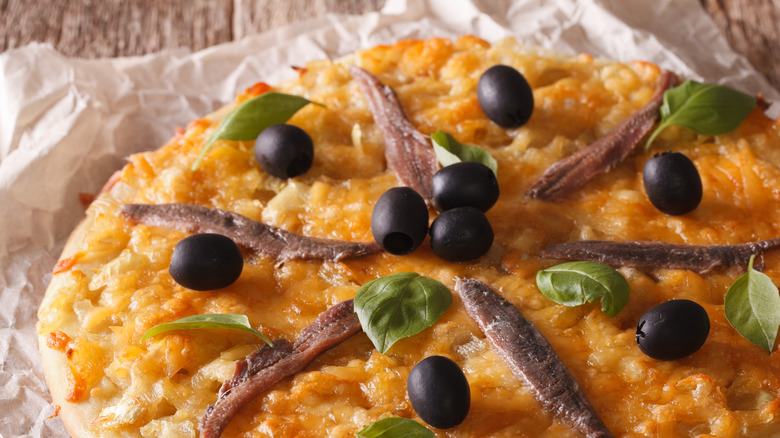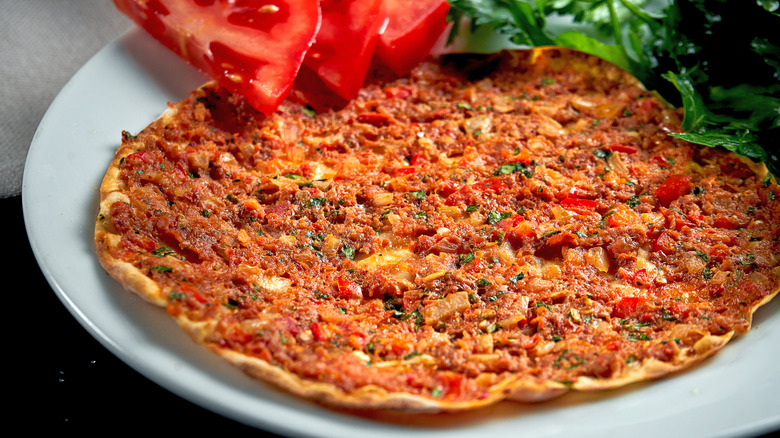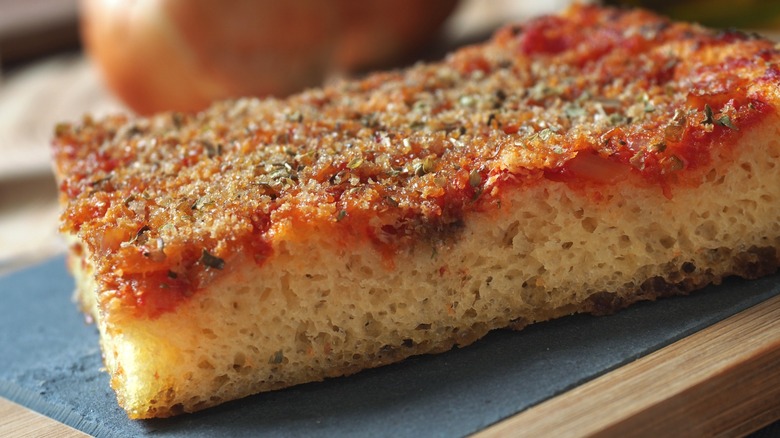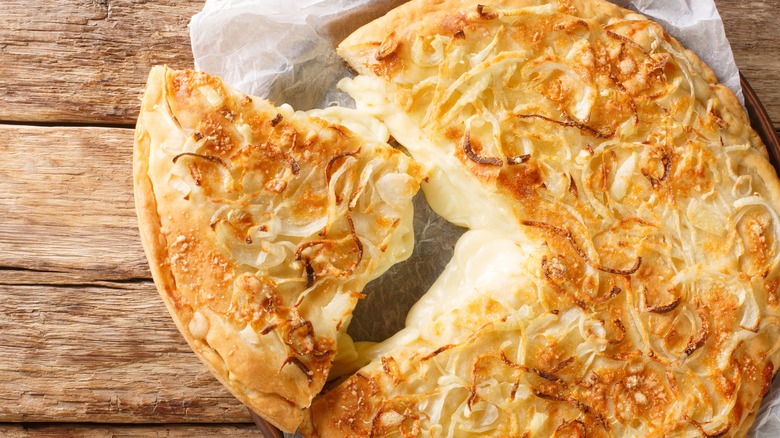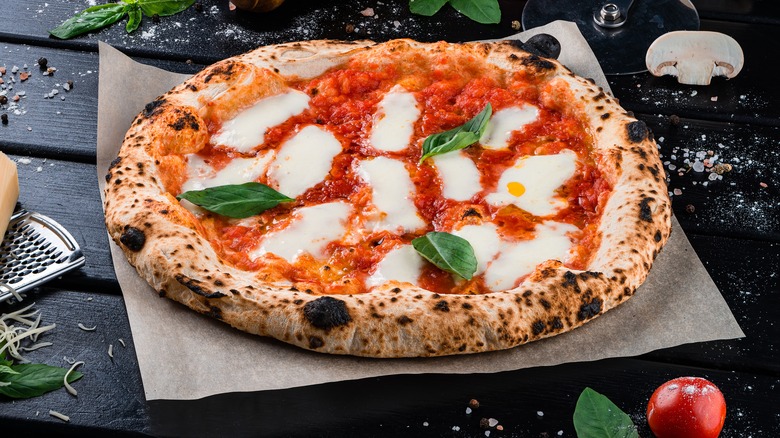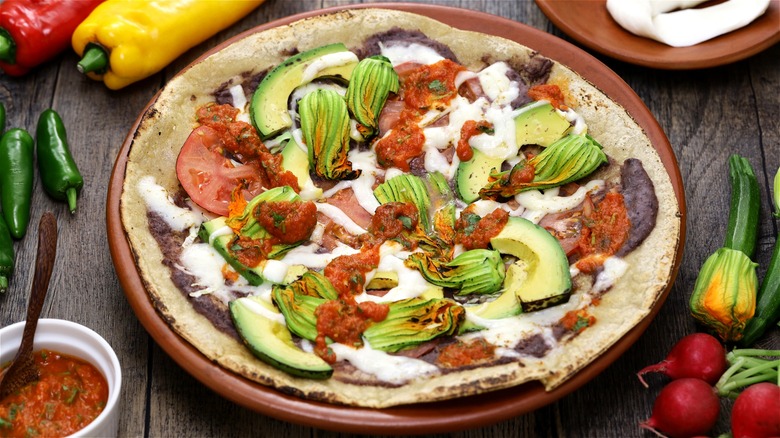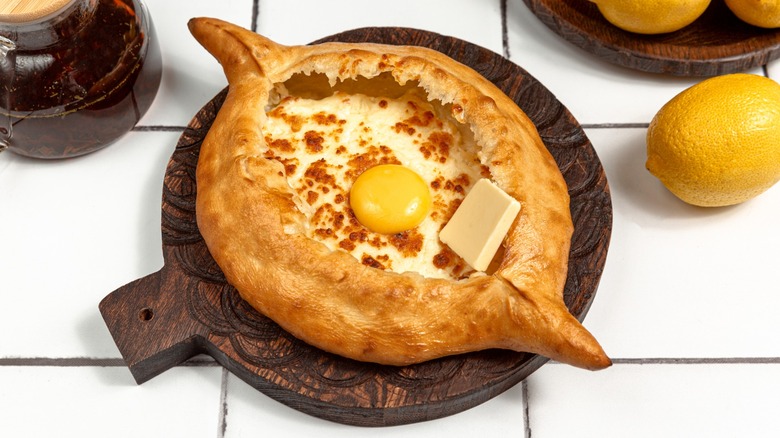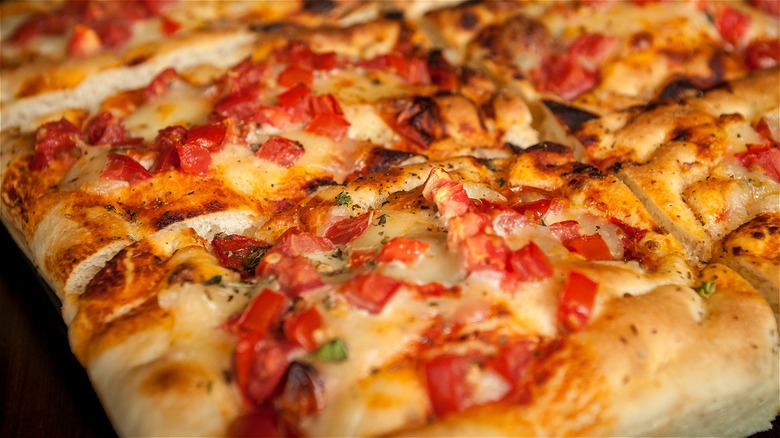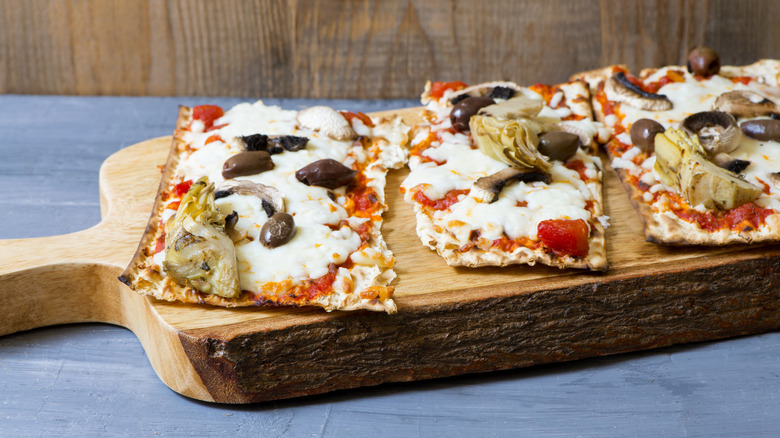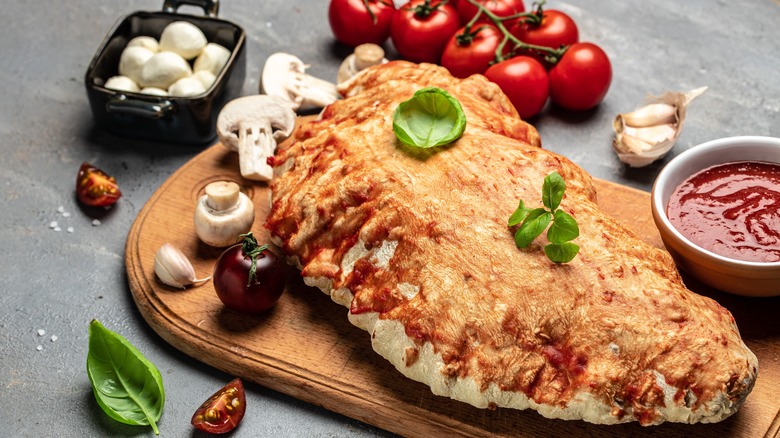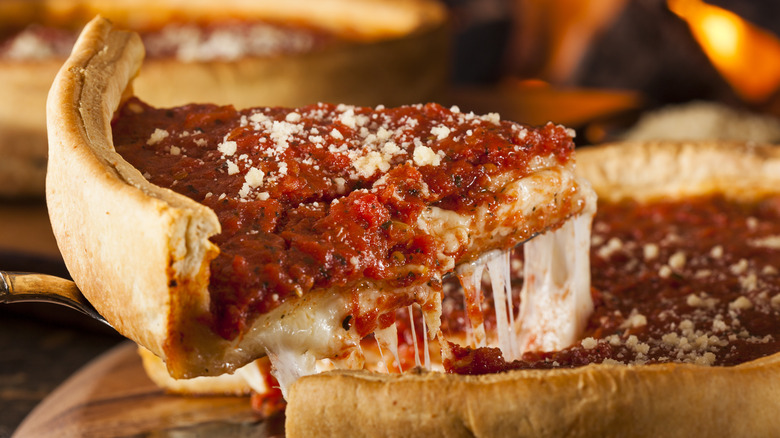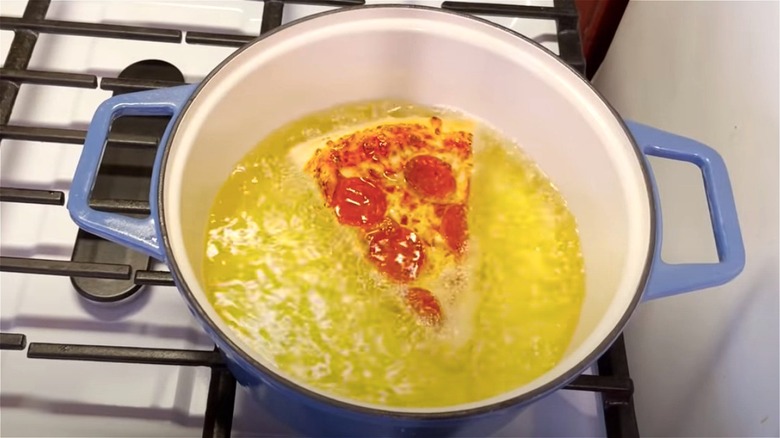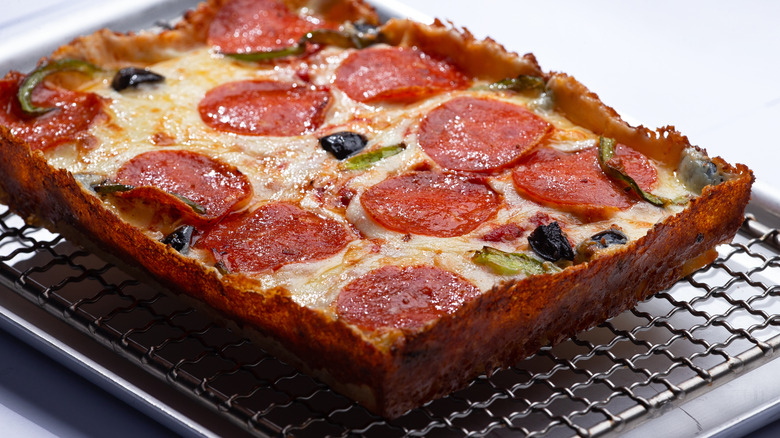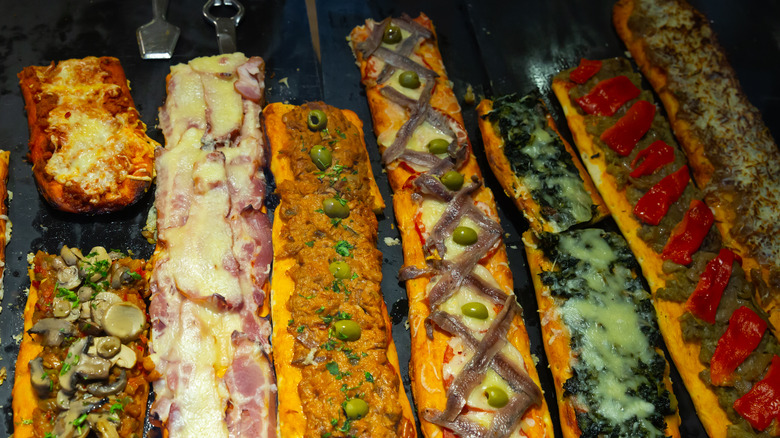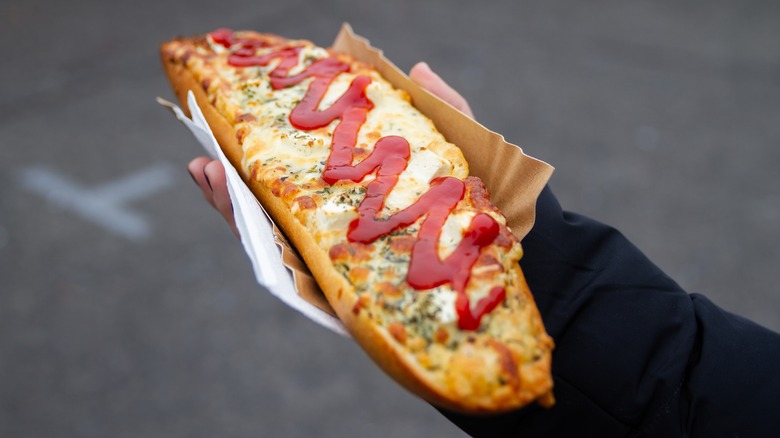20 Types Of Pizza Around The World
Humans have been eating bread with toppings for thousands of years. One of the earliest references was by the Roman poet Virgil, who described "thin wheaten cakes as platters for their meal" in his epic poem Aeneid. The characters top their "wheaten cakes" with foraged mushrooms and herbs and when they finish, one of them remarks, "Look! We've even eaten our plates!" Fast forward 2000 years — past the advent of margherita pizza in 1889 — and the joy of Virgil's "wheaten cakes" can be seen across the world.
In 2015, Americans were eating 100 acres of pizza a day — that's about 80 football fields — and in 2022, the western European pizza market reached a value of $58 billion, just shy of North America's $58.3 billion. Pizza today is a dish that reflects many local tastes and cultures. Consequently, pizzas may be thin or thick, sweet or savory, topped with anything from pork, egg, or beef to olives, anchovies, onions, and even batter. Here are 20 types of pizza from around the world.
1. Kebab pizza, Sweden
Pizza spread across Sweden in the 1960s and kebabs arrived some 20 years later. At some point in the 1980s, a bright spark thought to combine them and produce a most sophisticated example of fusion cuisine — the kebab pizza. A typical example features a thin or moderately thick base topped with cheese, tomato, doner meat, and kebab sauce.
The delicacy has become so popular in Sweden that academics at Dalarna University named kebab pizza as one of the nation's most popular dishes. It is especially popular on January 1, which has become a traditional day of pizza consumption in Sweden, presumably to soak up the quarts of alcohol consumed during New Year's Eve festivities.
2. Flammkuchen, France and Germany
Flammkuchen is from the Alsace region on the French/German border and it consists of thin, crunchy dough topped with soured cream and sprinkled with onions and cured ham — typically small pieces of streaky bacon or finely diced schinken, which is similar to lardons, only less fatty.
Flammkuchen is a lighter pizza style that can blur the line between appetizer and main; in any case, it provides a simple balance of dairy, garlic, and umami flavors that pair very well with beers from Alsace or any other German region, for that matter. (We tried this dish in Bavaria, hundreds of miles from Alsace.)
3. Dayton-style pizza, United States
If a "meat feast" doesn't cut it for you, then consider a trip to Dayton, Ohio, where local independents such as Cassano's (est. 1953) and Marion's (est. 1965) serve pizzas that are covered with edge-to-edge toppings and cut into small, square, "party" morsels. Beneath the avalanche of meat and cheese is a thin but airy dough base that's dusted with salt or cornmeal to add a satisfying, savory crunch.
According to the food historian Dann Woellert, Vic Cassano innovated the dense, square-cut style after hearing the complaints of women who found pizza a messy, undignified dish. It is unclear whether Cassano's ingenuity placated these refined eaters, but it certainly made a mark on America's regional pizzas.
4. Pissaladiere, France
The French city of Nice was under Italian control as recently as the 1850s, and it shows in the food. Pissaladiere is a round or rectangular pizza tart topped with olives, anchovies, and herbs upon a thick layer of caramelized onions, producing a sweet, salty, and oily dish that can serve as a hors d'oeuvre or a full meal.
Every recipe has a contention or two; in pissaladiere's case, there are disagreements about dough. Caroline Craig, author of "Provence: Recipes from the French Mediterranean," believes that authentic pissaladiere is made with bread dough. Others believe that buttery shortcrust pastry is the superior base to work with.
5. Lahmacun, Middle East
This Middle Eastern flatbread consists of a thin, round semolina dough base topped with a beef or lamb paste that is spread across the surface and mixed with vegetables including onion, chillies, eggplant, tomatoes, and parsley. Lahmacun is finished with seasoning such as paprika, cumin and lemon and is served either flat or rolled up.
The dish is popular across the region and especially in Turkey, where it is known as lahmacun. In neighboring Armenia, it is called lamadjo. In 2016, a so-called "pizza war" erupted between the nations when Armenian restaurateurs in Russia promoted lamadjo as a uniquely Armenian dish, prompting outrage in the Turkish press.
6. Sicilian, Italy
Americans may know Sicilian pizza as a thick, crisp, and rectangular offering lathered in tomato sauce and covered with cheese and assorted toppings, but that's now how it is in the old country.
The original style of Sicilian pizza — known by locals as sfincione in Italian or sfinciuni in the Sicilian dialect — has a focaccia-like form that's thick but thinner than its American derivative. There is a tomato base, too, but it is smeared rather than smothered. Then, instead of mozzarella in the American recipe, Palermo street food vendors opt for local cheeses such as caciocavallo or pecorino.
7. Fugazza, Argentina
Buenos Aires has some of the highest pizza consumption in the world and the fugazza style is among the most popular. Improvised in Banchero's pizzeria back in the 1930s, the classic fugazza pizza pairs a thick, focaccia-style base with a very liberal topping of thinly sliced caramelized onions.
The tomato-free offering is a fresh, crunchy balance of sweet and savoury flavors, but it may lack indulgence for some. In that case, they can opt for the fugazzeta variant, which stacks another layer of dough and stuffs a wad of mozzarella between them. If you sample the city's wares, some chefs may add artichoke, olives, and other Mediterranean staples.
8. Neapolitan, Italy
Chef, writer, and philosopher Vincenzo Corrado chronicled the Neapolitan pizza — or pizza Napoletana — in the early 18th century. He described what we now know as the marinara: a simple dough base with tomato sauce, garlic, and basil leaves.
Cheese wouldn't appear until 1889 when fabled pizza chef Raffaele Esposito added mozzarella and created a new variation — the margherita pizza. Legend has it that Esposito made the dish to honor Queen Margherita of Savoy, presenting an item that was humble, delicious, and emblematic of the red (tomatoes), white (mozzarella), and green (basil leaves) of the Italian flag.
9. Colorado-style, United States
In 1973, 25-year-old Chip Bair bought Beau Jo's pizzeria in Idaho Springs, Colorado for $8,500. The young entrepreneur told The Gazette that anything could be done with pizza, so he thought of ways to distinguish Beau Jo's from the competition. Bair began by removing sugar — which some chefs use to thicken pizza bases — and replacing it with honey, which imbued his dough with a unique flavor. Then, he arranged the crusts in large braids to create a big, puffy handle to support generous servings of meat, cheese, and other toppings.
Today, Beau Jo's Colorado-style pizzas weigh from one pound up to an enormous five pounds and are topped with hearty meats of your choice, including pepperoni, hamburger, bacon bits, andouille sausage, salami, and chicken.
10. Tlayuda, Mexico
Tlayuda or "Mexican pizza" is a popular street food — or antojito — found in Oaxaca, southern Mexico. The traditional dish comprises a large, corn tortilla that is baked and dried to produce a rigid base that can support a wide range of toppings including refried beans, lettuce, salsa, cheese, sliced tomato, avocado, beef, chicken, and pork.
The effect is a thin and crispy pizza-like item bursting with fresh, meaty, and zesty flavors. The best examples of the dish remain in Oaxaca, but you can expect some decent offerings far to the north in Mexico City, too.
11. New York-style pizza, United States
If the Neapolitan margherita is the origin of modern pizza, then the New York-style pizza is its first descendant. Italian immigrants developed the style in the early 1900s, especially Gennaro Lombardi, who opened America's first pizzeria — called Lombardi's — in 1905.
Since then, New York-style pizza has become world-famous for very large slices that can be folded and eaten on the go. The classic slice has a thin base topped with mozzarella cheese and a lively tomato sauce seasoned with salt, sugar, oregano, garlic, and pepper. Pepperoni and sausage may complete it for some, but locals claim that the secret ingredient comes from minerals in the city's water supply that imbue the dough with its renowned texture.
12. Khachapuri
Khachapuri is a big deal in Georgia. The small central Asian state is host to 47 varieties of the cheesy bread dish including the Adjarian style, which mixes flour, yeast, salt, cheese, butter, and an egg.
The dough is not so much a base as a bathtub, for it is prepared with a thick ridge that holds the cheese, butter, and egg in its core. Don't worry about spillages, though. Just rip the ridge away, bit by bit, and dip them in the indulgent mixture. It will only take a few bites to discover why khachapuri is so dear to Georgians' hearts.
13. Roman, Italy
There are two main pizza styles associated with Rome: pizza al taglio, which is a square, focaccia-like offering sold either by slice or weight, and pizza Romana tonda, which is a thin, round pizza much like its Neapolitan relative, only crispier.
We sampled each on a recent visit to the Italian capital and both were good, although if we had to pick a favorite, it would be pizza al taglio at Bonci, perhaps the most revered name in Roman pizza.
Anthony Bourdain is said to have enjoyed his time at Bonci so much that he claimed it was worth abandoning one's children for — and we have to agree. Imagine the perfect bite of an airy crust topped with velvet mozzarella cheese, earthy basil seasoning, and the piquancy of baked cured meat. That's Bonci pizza.
14. Matzah, Middle East
The Jewish holiday of Passover may forbid the consumption of leavened bread, but that doesn't mean pizza can't be kosher. The answer is matzah, an unleavened flatbread that can serve as a thin base for cheese, tomato and whatever else is required, namely artichokes, olives, and mushrooms.
Matzah pizza can be prepared by simply arranging the toppings on the bread and slotting it in the oven for about five minutes at 350 F, but some chefs recommend softening matzah by soaking it for 10 minutes or so.
15. Calzone, Italy
Calzone is perhaps the best-known example of a folded pizza. Appearing in 18th century Naples, the style allowed people to eat on the move and eat very well, too. This decadent pouch can feature numerous varieties of pork and cheese, namely salami, ham, lardons, ricotta, mozzarella, parmesan, and pecorino.
The only inconvenience here is the dough, which takes 24 hours to rise. But when that's done, the cooking time takes just minutes and the golden brown crescent that will greet you afterward should satiate both hunger and indulgent cravings.
16. Chicago deep dish, United States
Chicago's famous deep-dish pizza can be traced back to 1943 when entrepreneurs Ike Sewell and Ric Riccardo made it the star meal of their new restaurant, Pizzeria Uno. The deep dish took the Margherita and turned it into a huge savoury pie with layers of meat, cheese, vegetables and a thick, golden crust.
Pizzeria Uno is franchised across the world under the name Uno Chicago Grill, but the original restaurant remains with the same name and it is joined by numerous rival restaurants such as Lou Malnati's Pizzeria, Giordano's, and Gino's East.
17. Deep fried pizza, Scotland
During a visit to a chip shop in the Highlands town of Aviemore, we were shocked to see deep-fried pizza on the menu. "Welcome to Scotland, my friend," the cashier said, "we'll deep fry anything."
Many Scottish chip shops offer deep-fried pizza on the menu, along with battered fish, saveloy sausages, and deep-fried Mars bars. The typical cook will take a frozen pizza and fry it in oil until warm, and the result is ... subjective. Another method that is arguably even more outrageous is "pizza crunch," which adds a layer of batter to the pizza before frying.
18. Detroit-style pizza, United States
Detroit-style pizza was born in 1946 at Buddy's Rendezvous, a former speakeasy at 6 Mile and Conant. In a romantic piece of Motor City legend, Gus Guerra and his staff used steel pans from nearby auto plants to bake a batch of rectangular pizzas.
This form was novel not just in appearance but also texture and taste. Guerra double-stretched the dough to ensure it was thick but also fluffy, and he seasoned the pan to keep a lively flavor throughout the dense, heavy pie. The mix of Wisconsin brick cheese with a dash of oil was an inspired choice, too, for it produced the rich, buttery taste that is perhaps the most distinguishing feature of the style.
19. Coca, Spain
Coca is a diverse style of bread from Catalonia and wider Spain that can be adapted to almost any palate and occasion. The coca de trampo, for example, is a thin Majorcan flatbread topped with savory ingredients such as tomatoes, onions, peppers, and occasionally goat's cheese (although dairy is not customary).
Trampo is often cut into small square pieces, distinguishing it from coca de recapte, which is also stretched thin like a pizza but eaten in larger slices, owing to fish and meat toppings including anchovies, pork sausages, and cured meat. Cocas both sweet and savory are a popular fixture of Spanish cuisine and culture.
20. Zapiekanka, Poland
Supply chains in communist Poland were not conducive to culinary innovation. At some point in the 1970s, struggling cooks managed to improvise a hearty street food they called zapiekanka, which involved cutting a baguette lengthwise and adding butter, cheese, and white mushrooms before toasting it golden brown and adding ketchup to taste.
Decades later, this modest treat can be found in towns and cities across Poland and especially in Krakow, where it is served at the Plac Nowy roundhouse. Perhaps the most tempting thing about zapiekanka is how easy it is — it's a great substitute for an expensive, mediocre takeout meal.
